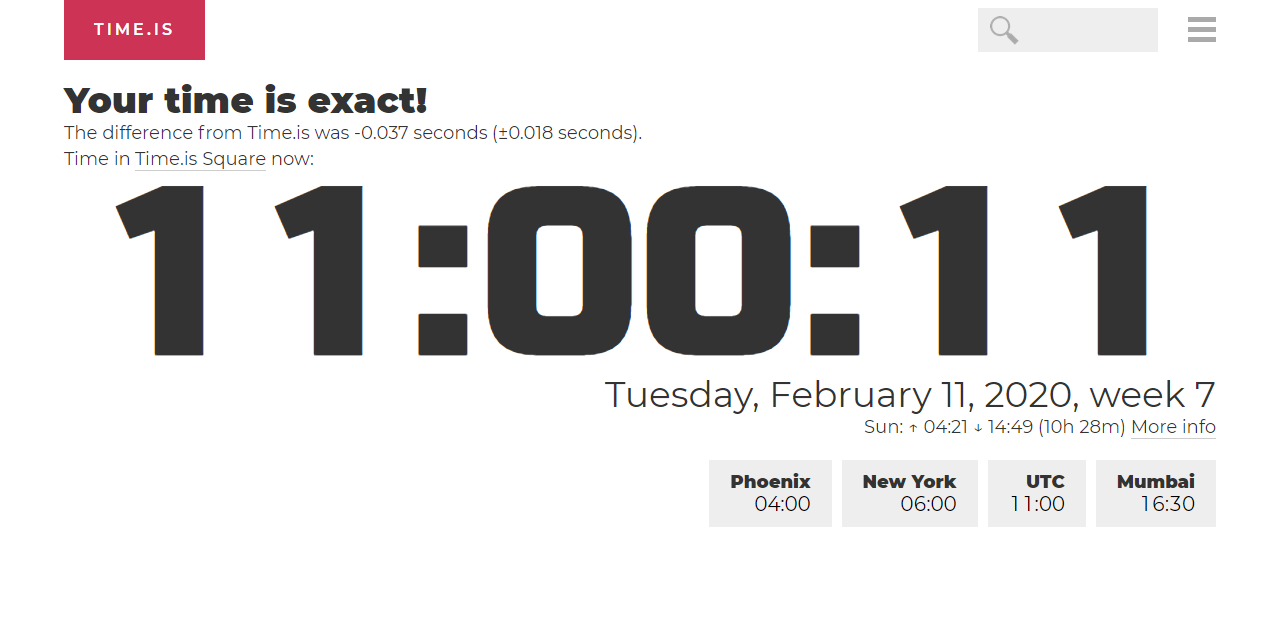UTC is the current international time standard that replaced GMT (Greenwich Mean Time). Greenwich, England lies on the zero longitudinal meridian so midnight is 'zero hours' UTC. Due to the earth's rotation, the sun will rise approximately 8 hours earlier in Greenwich than in Washington State. See, what time is 16:00 UTC (Coordinated Universal Time) in your local time Sunrises & Sunsets Around The World COVID-19 Pandemic Longest Day 2021 Solar Eclipse June 2021 New York City, US Toronto, Canada London, UK North Pole Qaanaaq, Greenland Countdown to 2022 Earth Time Clock. Coordinated Universal Time (UTC) is the world time standard that regulates clocks and time. It is successor to Greenwich Mean Time (GMT). For casual use, UTC is the same as GMT, but is used by the scientific community. UTC is the time standard commonly used across the world since 1972.
Wednesday, 21 April 2021
Fullscreen| Other names: | Universal Time Coordinated / Universal Coordinated Time |
|---|---|
| Successor to: | Greenwich Mean Time (GMT) |
| Military name: | “Zulu” Military Time |
| Longitude: | 0° (Prime Meridian) |
| At sea: | Longitudes between 7.5° West and 7.5° East |
| Note: | United Kingdom is one hour ahead of UTC / GMT during summer |
Time Zone
No DST

Difference
Tools & Converters
More about UTC
Time Zone Abbreviations
This page is updated monthly and contains a table of leap seconds, the current difference between the UT1 and UTC time scales, and the current UT1 - UTC difference that is being broadcast by NIST (called the DUT1 correction).
The master clock pulses used by the WWV, WWVH, WWVB, ACTS and Internet Time Service (ITS) time code transmissions are referenced to the UTC(NIST) time scale. Occasionally, 1 s is added to the UTC time scale. This second is called a leap second. Its purpose is to keep the UTC time scale within ±0.9 s of the UT1 astronomical time scale, which changes slightly due to variations in the rotation of the Earth.
See information about why we need leap seconds.
Leap Seconds
Coordinated Universal Time (UTC) is based on International Atomic Time (TAI), but it is adjusted by leap seconds to account for the difference between the definition of the second and the rotation of Earth. This correction keeps UTC in conjunction with the apparent position of the Sun and the stars, and it is the standard used for all general timekeeping applications.
The current difference between UTC and TAI is 37 seconds. (TAI is ahead of UTC by this amount)
No leap second was added at the end of December 2020.
No leap second will be introduced at the end of June 2021.
The first leap second was inserted into the UTC time scale on June 30, 1972. Leap seconds are used to keep the difference between UT1 and UTC to within ±0.9 s. The table below lists all leap seconds that have already occurred, or are scheduled to occur.
All leap seconds listed in the table are positive leap seconds, which means an extra second is inserted into the UTC time scale. The sequence of events is:
23h 59m 59s - 23h 59m 60s - 00h 00m 00s
Leap Seconds Inserted into the UTC Time Scale
| Date | MJD | Date | MJD | Date | MJD | Date | MJD |
|---|---|---|---|---|---|---|---|
| 2016-12-31 | 57753 | 1998-12-31 | 51178 | 1989-12-31 | 47891 | 1979-12-31 | 44238 |
| 2015-06-30 | 57203 | 1997-06-30 | 50629 | 1987-12-31 | 47160 | 1978-12-31 | 43873 |
| 2012-06-30 | 56108 | 1995-12-31 | 50082 | 1985-06-30 | 46246 | 1977-12-31 | 43508 |
| 2008-12-31 | 54831 | 1994-06-30 | 49533 | 1983-06-30 | 45515 | 1976-12-31 | 43143 |
| 2005-12-31 | 53735 | 1993-06-30 | 49168 | 1982-06-30 | 45150 | 1975-12-31 | 42777 |
| 1992-06-30 | 48803 | 1981-06-30 | 44785 | 1974-12-31 | 42412 | ||
| 1990-12-31 | 48256 | 1973-12-31 | 42047 | ||||
| 1972-12-31 | 41682 | ||||||
| 1972-06-30 | 41498 |
Current UT1-UTC values
UTC To Your Local Time Conversion -- TimeBie

This table lists the most recent differences between UT1 and UTC. This information is obtained from the United States Naval Observatory (USNO).
Weekly UT1-UTC Values

| Date | MJD | UT1-UTC(±5 ms) | UTC(USNO,MC) - UTC(NIST) (±20 ns) |
|---|---|---|---|
| 2021-01-28 | 59242 | -167.30 ms | -1.9 ns |
| 2021-01-21 | 59235 | -171.05 ms | -3.1 ns |
| 2021-01-14 | 59228 | -172.88 ms | -3.8 ns |
| 2021-01-07 | 59221 | -174.85 ms | -4.2 ns |
| 2020-12-31 | 59214 | -175.99 ms | -4.9 ns |
| 2020-12-24 | 59207 | -178.63 ms | -3.7 ns |
| 2020-12-17 | 59200 | -179.24 ms | 0 ns |
| 2020-12-10 | 59193 | -179.14 ms | -3.5 ns |
| 2020-12-03 | 59186 | -178.32 ms | -3.2 ns |
DUT1 corrections
Leap seconds ensure that UT1 - UTC will always be held within ±0.9 s. The current value of UT1 - UTC is called the DUT1 correction and is obtained from the Bureau International des Poids et Mesures (BIPM). DUT1 corrections are broadcast by WWV, WWVH, WWVB and ACTS, and are printed below. These corrections may be added to received UTC time signals in order to obtain UT1.
The resolution of the DUT1 correction is 0.1 s, and represents an average value for an extended range of dates. Therefore, it will not agree exactly with the weekly UT1-UTC(NIST) values shown in the earlier table, which have 1 ms resolution and are updated weekly.
Utc Time To Eastern Time
DUT1 (UT1-UTC) corrections broadcast by NIST
Utc Time Zone
| Start Date | Time | DUT1 Correction |
|---|---|---|
| 2019-05-02 | 0000 UTC | -0.2 s |
| 2019-01-17 | 0000 UTC | -0.1 s |
| 2018-09-21 | 0000 UTC | +0.0 s |
| 2018-03-15 | 0000 UTC | +0.1 s |
| 2017-11-30 | 0000 UTC | +0.2 s |
| 2017-06-29 | 0000 UTC | +0.3 s |
| 2017-03-30 | 0000 UTC | +0.4 s |
| 2017-01-26 | 0000 UTC | +0.5 s |
| 2017-01-01 | 0000 UTC | +0.6 s |
| 2016-11-17 | 0000 UTC | -0.4 s |
| 2016-09-01 | 0000 UTC | -0.3 s |
| 2016-05-19 | 0000 UTC | -0.2 s |
| 2016-03-24 | 0000 UTC | -0.1 s |
| 2016-01-31 | 0000 UTC | 0.0 s |
| 2015-11-26 | 0000 UTC | +0.1 s |
| 2015-09-11 | 0000 UTC | +0.2 s |
| 2015-07-01 | 0000 UTC | +0.3 s |
| 2015-05-28 | 0000 UTC | - 0.7 s |
| 2015-03-19 | 0000 UTC | - 0.6 s |
| 2014-12-25 | 0000 UTC | - 0.5 s |
| 2014-09-25 | 0000 UTC | - 0.4 s |
| 2014-05-08 | 0000 UTC | - 0.3 s |
| 2014-02-20 | 0000 UTC | - 0.2 s |
| 2013-11-21 | 0000 UTC | - 0.1 s |
| 2013-08-22 | 0000 UTC | + 0.0 s |
| 2013-04-11 | 0000 UTC | + 0.1 s |
| 2013-01-31 | 0000 UTC | + 0.2 s |
| 2012-10-25 | 0000 UTC | + 0.3 s |
| 2012-07-01 | 0000 UTC | + 0.4 s |
| 2012-05-10 | 0000 UTC | - 0.6 s |
| 2012-02-09 | 0000 UTC | - 0.5 s |
| 2011-11-04 | 0000 UTC | - 0.4 s |
| 2011-05-12 | 0000 UTC | - 0.3 s |
| 2011-01-06 | 0000 UTC | - 0.2 s |
| 2010-06-03 | 0000 UTC | - 0.1 s |
| 2010-03-11 | 0000 UTC | +0.0 s |
| 2009-11-12 | 0000 UTC | +0.1 s |
| 2009-06-11 | 0000 UTC | +0.2 s |
| 2009-03-12 | 0000 UTC | +0.3 s |
| 2008-11-20 | 0000 UTC | - 0.6 s |
| 2008-08-07 | 0000 UTC | - 0.5 s |
| 2008-03-13 | 0000 UTC | - 0.4 s |
| 2007-11-29 | 0000 UTC | - 0.3 s |
| 2007-06-14 | 0000 UTC | - 0.2 s |
| 2007-03-15 | 0000 UTC | - 0.1 s |
| 2006-12-22 | 0000 UTC | +0.0 s |
| 2006-09-28 | 0000 UTC | +0.1 s |
| 2006-04-27 | 0000 UTC | +0.2 s |
| 2006-01-01 | 0000 UTC | +0.3 s |
| 2005-03-17 | 0000 UTC | - 0.6 s |
| 2004-04-29 | 0000 UTC | - 0.5 s |
| 2003-04-03 | 0000 UTC | - 0.4 s |
| 2002-10-24 | 0000 UTC | - 0.3 s |
| 2002-02-14 | 0000 UTC | - 0.2 s |
| 2001-10-04 | 0000 UTC | - 0.1 s |
| 2001-03-01 | 0000 UTC | +0.0 s |
